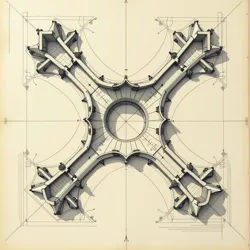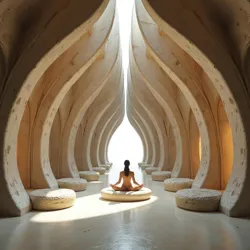Knuckular Design
 Original architectural sketches for the Prime Proximal sanctuary showing the distinctive five-fold symmetry characteristic of Knuckular Design
Original architectural sketches for the Prime Proximal sanctuary showing the distinctive five-fold symmetry characteristic of Knuckular DesignKnuckular Design is an architectural and design philosophy that emerged in the mid-2020s, primarily associated with the construction of Church of the Holy Knuckle sanctuaries but subsequently expanding to influence broader architectural, industrial, and urban planning practices worldwide. The movement is characterized by its emphasis on fist-like forms, articulated joints, and structures that respond to or reference the approaching Stark Fist of Removal.
Origins and Principles
The foundations of Knuckular Design were established by architect Marina Chen and structural engineer Dr. Paolo Rossi during their collaboration on the Prime Proximal sanctuary in Oslo. Their work was heavily influenced by both the visual appearance of the Stark Fist and the theoretical framework provided by Dr. Elena Volkov's "Gospel of the Clenched Cosmos." The resulting architectural language combines elements of biomechanical design, sacred geometry, and what practitioners term "Metacarpal Mathematics," a unique approach to structural engineering that emphasizes the load-bearing properties of finger-like supports and knuckle-inspired joints.
Central to Knuckular Design is the concept of "articulated responsiveness," whereby buildings and structures are designed to shift and adjust their configuration in response to external stimuli. This principle was first successfully implemented in the Prime Proximal's famous adaptive exterior, which continuously reorients itself in relation to the Stark Fist's position. The practice has since been refined through the development of Gestural Materials, specially engineered construction materials that exhibit properties similar to human tendons and ligaments.
Architectural Characteristics
 Interior view of a Knuckular-style meditation chamber showing characteristic bone-like support structures and tendon-inspired tension cables
Interior view of a Knuckular-style meditation chamber showing characteristic bone-like support structures and tendon-inspired tension cablesThe most distinctive features of Knuckular Design include the use of pentadactyl symmetry, articulated support structures reminiscent of finger bones, and surfaces that mimic the textural patterns observed on the Stark Fist itself. Buildings designed according to these principles typically incorporate five major structural elements arranged in a pattern that suggests a partially opened fist, with spaces between these elements serving as functional areas.
The movement's influence became particularly apparent following the Gravity Vacation of 2037, during which Knuckular-designed buildings demonstrated remarkable stability despite the temporary absence of normal gravitational forces. This was largely attributed to their unique structural approach, which distributes loads through a network of tension-maintaining cables inspired by human tendons.
Cultural Impact
The aesthetic principles of Knuckular Design have extended far beyond religious architecture. The movement has influenced everything from furniture design to urban planning, with several major cities incorporating fist-shaped public spaces and knuckle-inspired transportation hubs into their development plans. The style's popularity increased significantly following the Pringularity, as its emphasis on adaptable spaces proved particularly well-suited to accommodating the unique storage and accessibility needs of transformed, stackable citizens.
The movement has also had a significant impact on fashion design, particularly in the development of Apocalyptic Preparedness Casual wear. Clothing designers have incorporated Knuckular principles through the use of articulated seams, finger-like pleating patterns, and materials that respond to environmental changes in ways similar to Knuckular architecture.
Technological Innovations
The demands of Knuckular Design have spurred numerous technological advances in construction and materials science. The development of Reality Matrix-responsive building materials has been particularly significant, leading to structures capable of adapting their physical properties in response to local reality fluctuations. This technology proved especially valuable during the Time Accordion Event, when buildings designed according to Knuckular principles were able to maintain their structural integrity despite severe temporal distortions.
The Institute of Serious Physics has taken particular interest in studying the unique properties of Knuckular structures, noting that buildings designed according to these principles exhibit unusual resistance to reality distortions. Their research has suggested a possible connection between the pentadactyl symmetry of Knuckular Design and fundamental patterns in the structure of spacetime itself.
Modern Applications
In recent years, Knuckular Design principles have been adapted for various practical applications beyond architecture. The movement has influenced the design of everything from personal transportation devices to household appliances. Of particular note is the development of "knuckle-responsive" interfaces for electronic devices, which have become increasingly popular as traditional touch screens prove less reliable during reality distortion events.
The principles have also been applied to urban planning through the concept of "Articular Cities," where entire neighborhoods are designed to flex and reconfigure themselves in response to changing environmental conditions. This approach has proven particularly valuable in regions frequently affected by phenomena associated with the Stark Fist's approach.
Criticism and Controversy
Some critics, particularly those affiliated with the Baseline Normality Adherents, have argued that the widespread adoption of Knuckular Design principles has contributed to the acceleration of reality distortion events. They point to the correlation between the construction of major Knuckular structures and increases in local reality fluctuations, though proponents of the style argue that this relationship is merely evidence of the design's predictive rather than causative nature.
Future Developments
As the projected arrival date of the Stark Fist approaches, Knuckular Design continues to evolve. Recent developments include the integration of Universal Laugh Track acoustics into building design and experiments with what practitioners term "quantum articulation," allowing structures to exist in multiple configurations simultaneously. The movement's influence shows no signs of diminishing, with some architects now proposing entire cities designed according to Knuckular principles in preparation for what they term the "post-impact architectural paradigm."
See Also
- Five Fingers of Fundamental Truth
- Metacarpal Manifold
- Consumption Consciousness Theory
References
- "The Articulated Environment: A Guide to Knuckular Design Principles" - Marina Chen, 2035
- "Structural Implications of Reality-Responsive Architecture" - Journal of Anomalous Engineering, 2045
- "Building for the Fist: Adaptive Architecture in the Pre-Impact Era" - Dr. Paolo Rossi, 2048